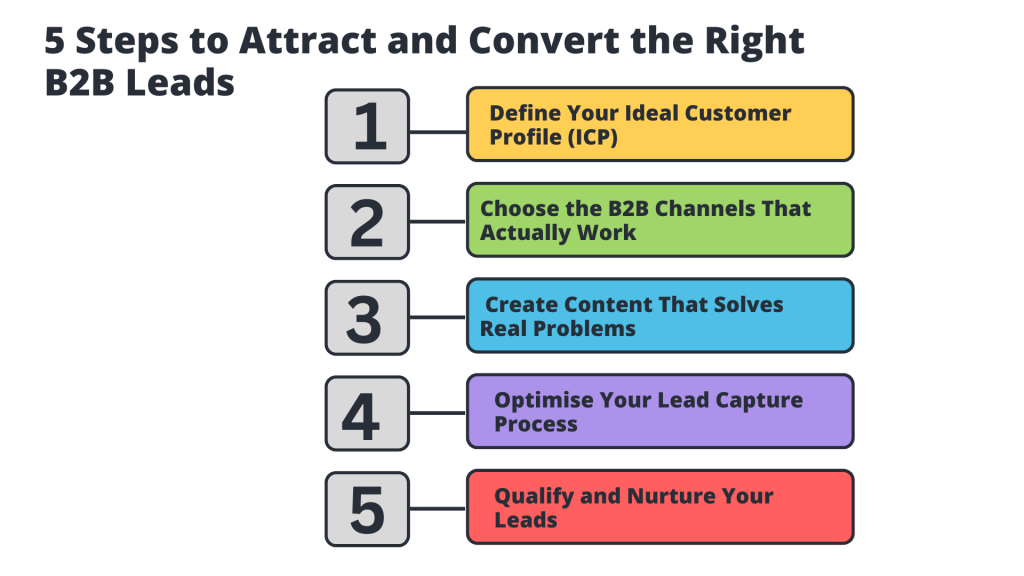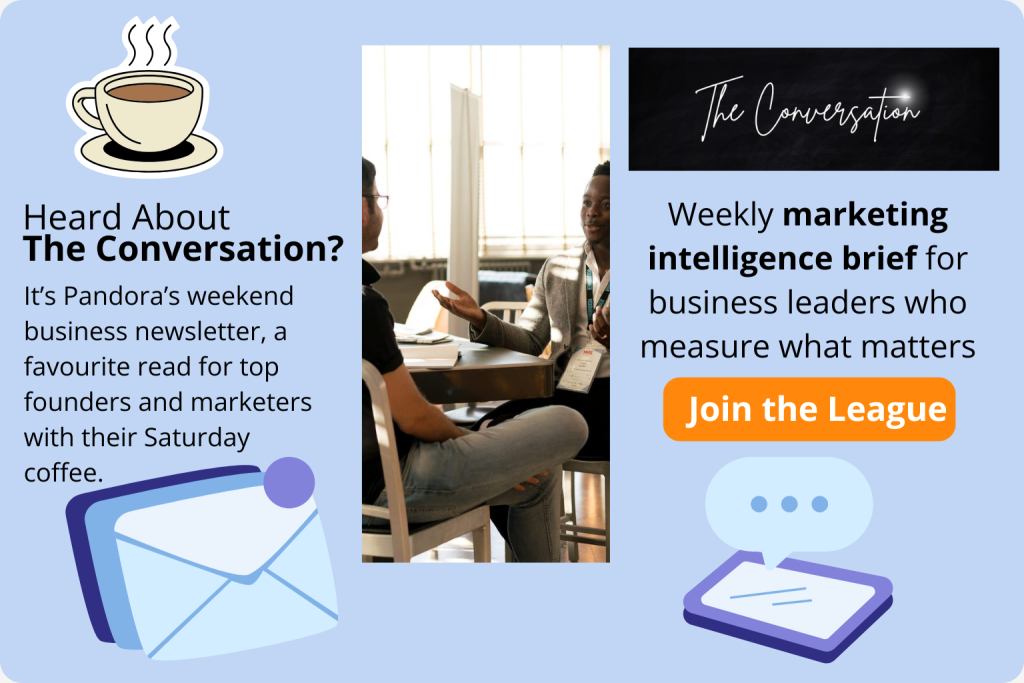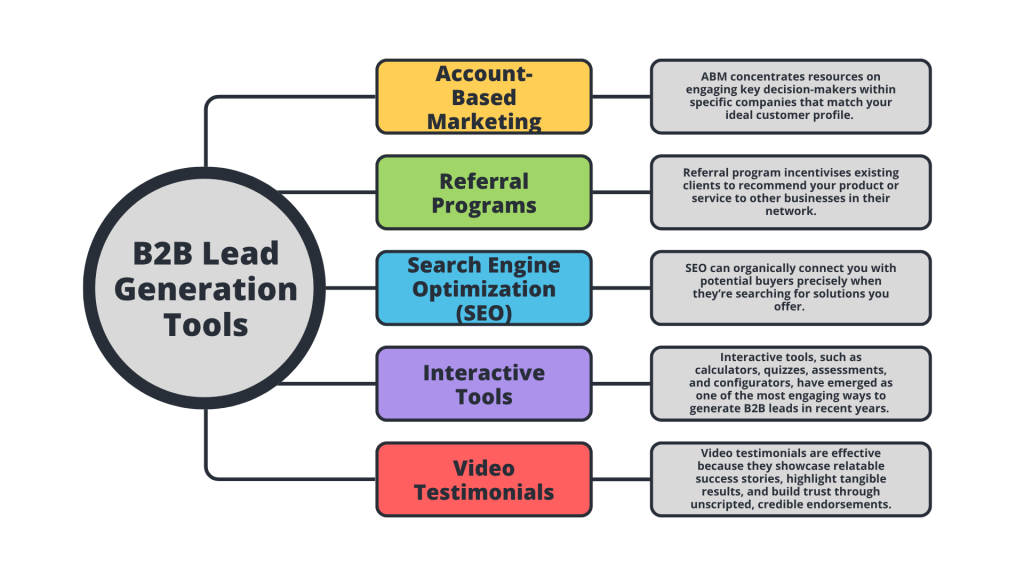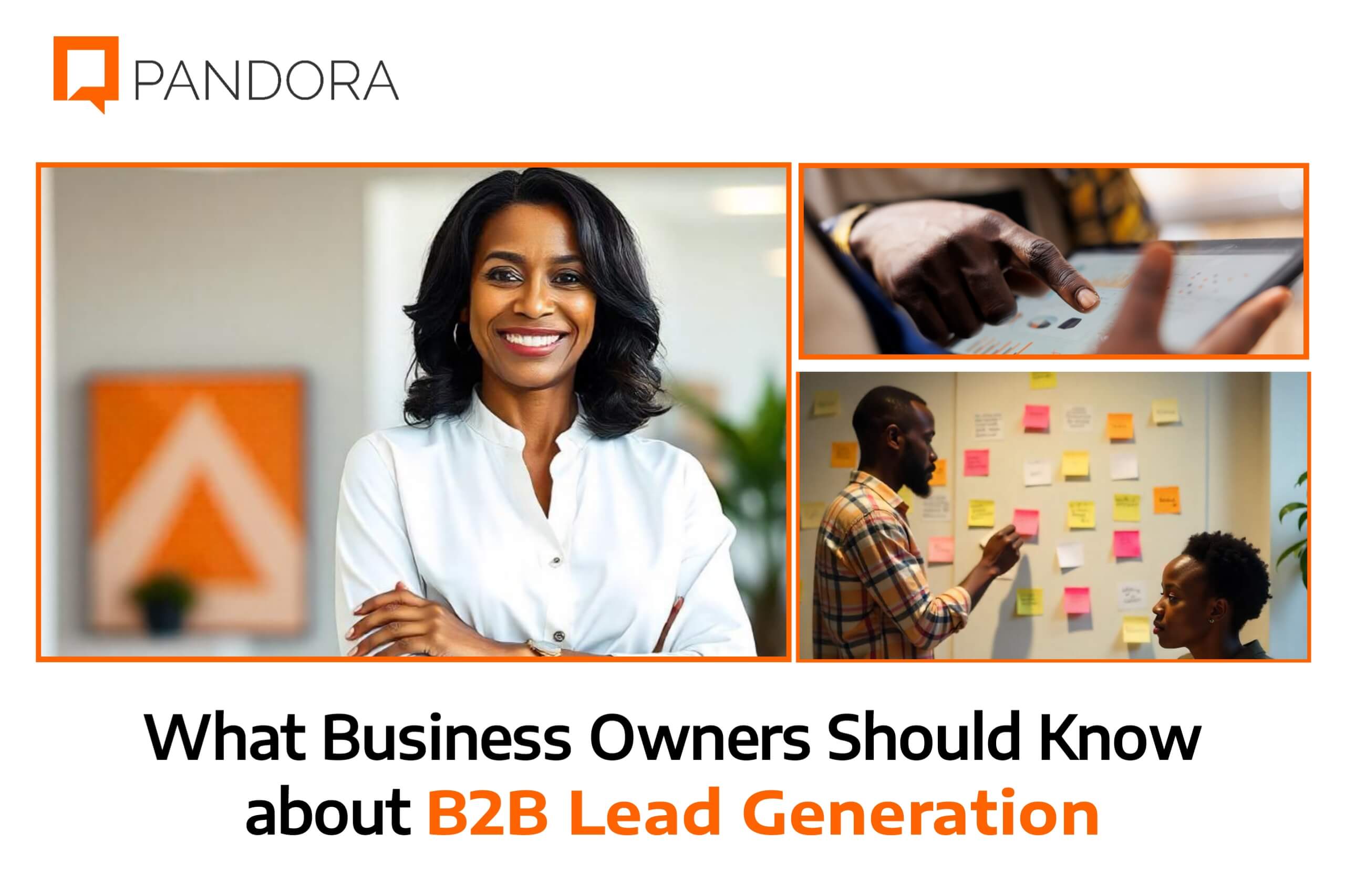Have you noticed that B2B lead generation isn’t always straightforward? Typically, before making a sale, you need to identify the right decision-makers, establish trust, and guide them towards a meaningful business relationship.
But here’s the good news: with the right approach, generating high-quality B2B leads becomes less of a guessing game and more of a strategic, repeatable process that fuels your business growth.
The challenge? Many businesses either chase the wrong leads or rely on outdated tactics that waste time and resources.
That’s not what we want for your business. You deserve a lead generation strategy that brings in the right people, the ones who actually need your solution and have the authority to buy.
Ready to explore? Let’s go!
What Is B2B Lead Generation?
B2B lead generation is the process of attracting and capturing potential customers (leads) for your business from other organisations. B2B lead generation is basically how you get potential customers for your business. Leads are qualified individuals who fit your ideal customer profile and show interest in your product or service.
It can be inbound lead generation with strategies like content marketing, SEO, landing pages, webinars, and outbound, including cold calling, cold emailing, and PPC advertising. However, our focus today is on three key actions that should guide your lead-generation efforts for optimal results.
Quality B2B lead generation:
- Increases brand awareness
- Builds relationships with key decision-makers
- Shortens the sales cycle
- Drives predictable revenue
In today’s competitive business landscape, effective lead generation is the oxygen that keeps your sales pipeline alive.
5 Steps to Attract and Convert the Right B2B Leads

If you want to generate leads that turn into real business opportunities, you need a structured, data-driven approach that targets the right people on the right platforms with the right message.
Here’s how to do it:
1. Define Your Ideal Customer Profile (ICP)
Before chasing leads, you need to be clear on who you’re actually targeting.
Your Ideal Customer Profile is a detailed description of the type of company (and decision-makers within it) that would benefit most from your solution.
Your ICP should cover the following:
- Industry and company size
- Revenue range
- Pain points and business challenges
- Key decision-makers and influencers
- Purchasing process
For example, Salesforce doesn’t market its CRM software to small local businesses with five employees. Their ideal customers are large, growth-oriented companies seeking to scale their operations and enhance customer management.
When you know your ICP, your marketing becomes laser-focused, and your lead quality improves dramatically.
2. Choose the B2B Channels That Actually Work
Not all platforms are created to work for you when it comes to B2B lead generation. You don’t need to be everywhere; you need to be where your ideal customers are.
Here are proven channels that top-performing B2B businesses rely on:
With over 1 billion members globally and more than 65 million decision-makers on the platform (Source: LinkedIn), LinkedIn remains the undisputed king of B2B lead generation.
But don’t just go pitching strangers in their inbox. Here’s what to do instead:
- Publish insightful content that builds credibility
- Engage in relevant industry groups and discussions
- Connect with your target audience and build genuine relationships
Companies like Pandora Agency Limited, HubSpot, Gartner, and Adobe use LinkedIn not just to promote but to educate, inspire, and build lasting B2B connections.
YouTube
YouTube may not be the first platform that comes to mind for B2B leads, but it should be. According to Demand Gen’s 2024 Content Preferences Report, 70% of B2B buyers watch videos during their decision-making process.
B2B brands like SEMrush and Hootsuite have mastered YouTube by sharing tutorials, product explainers, and industry insights that attract and nurture qualified leads without the hard sell.
Email Marketing
Despite the hype surrounding newer platforms, email remains one of the most effective tools for B2B lead generation.
In fact, Campaign Monitor reports that email marketing generates $42 for every $1 spent, a staggering ROI if done right.
The key? Personalisation and relevance. Segment your audience, provide value-driven content, and nurture leads with timely, helpful emails rather than aggressive sales pitches.

3. Create Content That Solves Real Problems
Content is the fuel for your B2B lead generation engine, but not just any content. It needs to address your target audience’s specific challenges and their decision-making process directly.
The most successful B2B marketers create content that educates, builds trust, and positions their brand as the logical solution
Here are content formats that drive results:
- Blogs and Guides: Provide in-depth answers to industry-specific questions
- Case Studies: Show real-world examples of how you’ve solved similar problems
- Webinars and Events: Demonstrate your expertise live, answer questions, and build relationships
- Lead Magnets (eBooks, Templates): Offer valuable resources in exchange for contact details
For instance, cybersecurity company CrowdStrike publishes threat reports and security guides that attract IT decision-makers concerned about digital risks. It’s not just content; it’s content that converts.
4. Optimise Your Lead Capture Process
To optimise your lead capture process, you need to make it as simple, clear, and engaging as possible for potential customers to share their information.
Start by creating well-designed landing pages with concise, benefit-focused messaging that explains precisely what visitors will get in exchange for their details, whether it’s a free resource, product demo, or consultation.
Keep forms concise and only request essential information to minimise friction. Use strong calls to action that guide people clearly on what to do next. It also helps to test different formats, such as pop-ups, embedded forms, or interactive tools like quizzes, to determine which one yields the best results.
Then, ensure your website loads quickly, functions well on mobile devices, and integrates seamlessly with your CRM or email marketing system, allowing leads to be captured and followed up on promptly. Finally, review your process regularly, use analytics to track conversion rates, and make data-driven tweaks to improve performance over time.
Companies like Drift and HubSpot utilise chatbots and smart forms to streamline lead capture, making it easy for interested prospects to connect.
5. Qualify and Nurture Your Leads
Not every lead is ready to buy today, and that’s okay. A structured lead nurturing process helps you stay top-of-mind and move prospects through the sales funnel.
Use:
- Lead scoring to prioritise high-potential prospects
- Email sequences to share relevant content based on their stage
- Retargeting ads to stay visible to interested website visitors
This approach ensures your sales team focuses on warm, qualified leads and your marketing efforts continue building relationships over time.
Proven B2B Lead Generation Tools to Try in 2025

The B2B landscape evolves quickly, but these tactics have consistently delivered strong results:
1. Account-Based Marketing
Account-based marketing, often referred to as ABM, is a strategic approach where businesses focus their marketing and sales efforts on a clearly defined set of high-value target accounts.
ABM concentrates resources on engaging key decision-makers within specific companies that match your ideal customer profile. What makes ABM fascinating is how personalised and precise it is.
A report by ITSMA reveals that 87% of marketers say ABM delivers a higher ROI than any other marketing strategy. It works by aligning the marketing and sales teams to identify the right accounts, researching those organisations, and crafting customised campaigns designed to resonate with each account’s unique needs.
These campaigns often include tailored content, personalised outreach, and targeted advertising, ensuring that the message speaks directly to the decision-makers.
By treating individual companies as markets of one, ABM not only increases the chances of conversion but also shortens the sales cycle and enhances customer relationships, making it one of the most effective B2B lead generation tactics for companies with long, complex buying processes.
2. Referral Programs
Referral programs are another powerful yet often underestimated B2B lead generation tactic that turns satisfied customers into enthusiastic brand advocates.
At its core, a referral program incentivises existing clients to recommend your product or service to other businesses in their network. What makes referrals especially valuable in B2B is the element of trust.
According to Nielsen, 92% of people trust recommendations from individuals they know over any form of advertising, and this trust is even more pronounced in professional circles.
A well-structured referral program usually offers incentives, such as discounts, account credits, exclusive services, or even cash rewards, to clients who successfully refer new customers. The beauty of this system is that it taps into existing relationships and networks, leading to higher-quality leads that are more likely to convert.
It works by building on the positive experiences of current customers, turning them into ambassadors who vouch for your brand in authentic, organic ways.
In highly competitive B2B markets where trust and credibility can take years to establish, a referral from a satisfied customer can expedite the buying process and open doors that traditional marketing efforts often cannot reach.
3. Search Engine Optimization
Search engine optimisation strategy combined with content marketing has remained a cornerstone of B2B lead generation for connecting you with potential buyers precisely when they’re searching for solutions you offer.
Studies show that 75% of B2B buyers start their research with a Google search and businesses that blog consistently get 67% more leads than those that don’t.
When done correctly, SEO and content marketing generate consistent, cost-effective leads with higher conversion potential compared to many outbound strategies.
4. Interactive Tools
Interactive tools, such as calculators, quizzes, assessments, and configurators, have emerged as one of the most engaging ways to generate B2B leads in recent years.
These tools provide value while collecting important information from potential customers. For example, a SaaS company might offer a cost-savings calculator that helps businesses estimate the potential savings they could achieve by switching to their software.
In exchange for the result, users often provide their contact information, turning an interaction into a qualified lead. According to Demand Gen’s report, 45% of buyers surveyed said interactive content is one of their top three preferred content types.
The appeal lies in how these tools make the experience personalised and informative. They work by guiding prospects through a self-discovery process where they receive tailored insights, whether it’s estimating ROI, diagnosing pain points, or recommending solutions.
This not only captures leads but also qualifies them, providing your sales team with valuable context before making contact. In an age where buyers crave control and customisation, interactive tools help businesses stand out while collecting high-quality leads.
5. Video Testimonials
Video testimonials have become an essential part of modern B2B lead generation because they combine two of the most influential elements in purchasing decisions: social proof and storytelling.
A video testimonial features real customers sharing their positive experiences with your product or service, offering an authentic perspective that resonates with potential buyers.
According to Wyzowl’s 2024 Video Marketing Statistics, 82% of people say they’ve been convinced to buy a product or service by watching a brand’s video.
This is especially impactful in B2B, where purchasing decisions often involve significant investment and multiple stakeholders. Video testimonials are effective because they showcase relatable success stories, highlight tangible results, and build trust through unscripted, credible endorsements.
Unlike written reviews, video adds a human element that captures emotion, tone, and sincerity, making the message more believable. They can be used on landing pages, in email campaigns, during sales presentations, or on social media to influence decision-makers at various stages of the buyer’s journey.
By showing prospects that other businesses like theirs have succeeded with your solution, video testimonials help overcome objections and accelerate lead conversion.
What Business Owners Should Know about B2B Lead Generation
The essence of lead generation is to help potential customers see your business, boost your awareness, and let them know who you are. The aim is to encourage them to engage with your brand and ultimately patronise your business.
You must understand that B2B lead generation requires some strategic actions for success. These actions must be integrated into your lead generation strategies for a desirable outcome. Let’s go through them briefly below.
1. Create Your Ideal Customer Profile
The first step to getting your lead generation efforts right is knowing who you want to sell to. Toyota and Ferrari are car companies, but their audience segments differ. You can’t sell a Toyota car to a Ferrari customer, no matter how cheap.
Your ideal customer profile is, therefore, a picture of the perfect customer who you want to attract to your business. They are people who probably know or don’t know about you, but you want to get their attention.
So, basically, if you’re doing lead generation, you are marketing to get the attention of your ideal buyer. However, you’re getting their attention through a sales process so that you can solve their problems by giving them value.
Here is what an ideal customer profile should consist of:
- Description of who the ideal customer is
- The customer’s demographics
- The customer’s business objectives/desires
- Pain points/challenges of the customer
- The customer’s behaviours and traits
2. Know the Channels That Work
Having worked with different clients in both B2B and B2C, we have noticed that not all channels work for each business category at the same level. Hence, we will walk you through the channels that have performed the best for the B2B companies we have worked with.
A. LinkedIn
One of the places we’ve found where you can really target your ideal customer profile and get quality people to get to know your business is LinkedIn. While you may find your customers on other platforms like Twitter, they are not there to buy your product.
While there may be exceptions to the above statement, core business buyers are on LinkedIn, and the most important thing about LinkedIn is that it gives you organic reach.
When you compare this to platforms like Facebook, where your followers may not see most of your content without paid ads, you can actually get more people to know more about you on LinkedIn. This is why LinkedIn has been one of the most effective platforms for growing B2B companies.
How do you grow on LinkedIn? One way is to make consistent posts on relevant topics in your niche. This should consist of useful and value-driven content that can help other businesses and professionals in your industry.
Another way to grow on LinkedIn as a B2B business is by connecting with people and directly messaging them. If you connect with people and make posts consistently, your connections will see your posts.
YouTube
This might come as a surprise, but YouTube is one of the best platforms to acquire customers. It is especially good for SaaS B2B lead generation. Here’s an illustration for clarity:
If you run a lead generation company, for instance, you can create YouTube videos to teach people different things about lead generation and marketing in general.
When you create these free courses or tutorials, you draw people to your channel, where they get valuable information and, at the same time, get to know what you do.
While this might be a lot of work, it is worth the effort. You can also host webinars and events and post them on YouTube and other channels. This will help people know more about you and trust you because of the useful knowledge you offer.
This is important because it will help you cut through the noise, as so many people do what you do. So trust is important, and gaining it makes the sales and conversion processes easier.
3. Create the Content They Want
Content, they say, is king, but the right content brings paying customers. Identifying customer pain points is super important to help you grow your business.
The better you understand your customers’ needs, the easier it is to sell to them. This is why you need to know what your audience desires. This includes the problems they are seeking solutions for. When you discover this, you’ll be able to create content that can meet their needs and in the format they want.
You might also want to check out our thoughts on SaaS B2B Content Marketing Strategy | By Pandora Agency.
Final Thoughts
B2B lead generation is the combination of strategy, consistency, and building real connections.
If you want to set your business up for sustainable growth. You’ll need to define your ideal customer, choose the right channels, create value-driven content, optimise your lead capture process, and nurture relationships. That’s what an effective lead generation strategy helps you achieve.
The most successful B2B brands don’t chase random leads; they attract the right ones and convert them into long-term partnerships.
If you’re ready to generate high-quality leads that actually convert, start with these principles we shared. And remember, in the world of B2B, trust is your most powerful marketing tool.





Great article about b2b lead generation!
Glad you enjoyed it!
Thanks, Lukas!
Nice blog! Simple yet impactful.
Thanks, Ronak. Glad you enjoyed it!